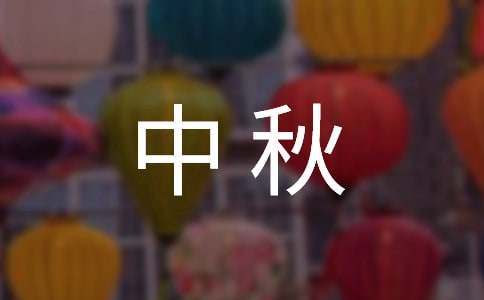中秋的起源及其文化内涵
篇一:中秋的起源及其文化内涵

中秋是月节,是以圆月为标志、寄寓着中华儿女团圆的梦想、积淀着中华儿女团圆的心理诉求的节日。各地区、各民族过节的习俗异趣纷呈,然而万变不离其宗的是中秋所体现出的中华文化的基本特征,它凝聚着中华儿女的心,熔铸着中华儿女的魂。
从祭月到赏月
中华民族有自己独特的月亮文化。月亮称“太阴”,与太阳分别成为中华文化中代表阴阳的“两极”。月亮崇拜古已有之——远古先民看见月出月落、月缺月圆,感受到一股神秘的力量支配着大地,心生敬畏。《礼记》载,“天子春朝日,秋夕月”。自周朝起,中国就有祭月仪式,且祭月的习俗绵延不绝,现在北京的月坛即为明清帝王祭月的场所。祭月扩至民间,民众亦有广泛的拜月习俗。 随着文明发展,人们对月亮的敬畏心理逐步减淡,观赏心态逐步加强。长期的农耕社会,使中华民族对月亮自古以来就有细致的体察。阳历15号月不必圆,而华人的农历,每月十五总是月圆。正月十五元宵、七月十五中元、八月十五中秋,都是传统大节。太阳总是圆的,而月亮变化不居,中华儿女细致地为之命名:朔、望、晦;上弦月、满月、下弦月;月牙儿、一钩新月、一轮满月。 在对月亮的观察中,人们逐渐发现“月到中秋分外明”。秋分时太阳光线垂直照射在赤道上,一天的昼与夜等长,古时祭月选择在秋分。但秋分多不是满月,农历八月十五是最接近秋分的一个满月之日。此日秋高气爽,夜空如洗,月亮又大又圆,于是中秋节就选择在了八月十五。加之这时正是秋收时节,五谷丰登、瓜果满架,人们的心情最是喜悦。到唐代,中秋节正式形成,赏月逐渐成为全民族的习俗。
与西方狂欢节的格调不同,中国的中秋是恬静清雅的。传说唐明皇游月宫,见城楼门匾上写着“广寒清虚之府”,便称月宫为“广寒宫”。京剧《贵妃醉酒》里,杨贵妃自比广寒宫的嫦娥,称月亮为“冰轮”“玉兔”。中秋呈现的多是“寒”“清”“冰”“玉”之意境,我们要找回并学会欣赏中秋节的这种美。 拜月赏月萌发的天人之思宁静而朦胧的月夜,让人澄思静虑。人们在敬畏拜月、融情赏月的同时萌发了天人之思。
张若虚《春江花月夜》写道,“人生代代无穷已,江月年年只相似”。月亏而盈,盈而复亏,却永远照耀在历史的长空。月亮永久而人生短暂,人生能不能像月亮那样生生不息?屈原在《天问》中发出“夜光何德,死则又育”之问。李白《把酒问月》从“人攀明月不可得,月行却与人相随”写到“今人不见古时月,今月曾经照古人。古人今人若流水,共看明月皆如此。”
苏东坡承屈原、李白之意,写了《水调歌头·明月几时有》,把中华月亮文化中的`人伦情思和天人哲思熔于一炉,炉火纯青。
词前小序说:“丙辰中秋,欢饮达旦,大醉,作此篇,兼怀子由。”子由即苏辙。苏轼和苏辙是情深意笃的兄弟,苏轼每到一个地方,都有诗文寄给苏辙。苏轼原在杭州任通判,因为苏辙在济南做官,所以他特地请求北徙,来到密州,就是现在的山东诸城任职。虽然两个地方相隔不远,但是兄弟俩还是好久不能见面,苏辙在词中是作为不能团聚的亲人的代表。
“明月几时有?把酒问青天。不知天上宫阙,今夕是何年?”明月和月宫都是仙界,亘古恒久无须也无从纪年。无须问而偏要问,这是醉了,是“究天人之际”的哲思。月光“转朱阁,低绮户,照无眠”,先在楼阁间搜寻作者,没找到,钻进窗户搜寻,终于找到了这个因思念亲人而无眠的词人苏轼。“不应有恨,何事长向别时圆?”你找我干什么?该不会也因情衔恨吧,怎么总以团之月撩拨不团圆之人?反差越大,思念之苦越深!所以,对圆月的怨责,表达的是思亲的情深、情苦。这是一种憾恨。如何排解呢?
“人有悲欢离合,月有阴晴圆缺,此事古难全。但愿人长久,千里共婵娟。”月亮也并不总是圆的,它阴晴圆缺,周而复始,代表着一种流转的轮回。人若能融入其中,也就能参透日月造化之永恒,赞服天地之化育。这样一来,人间之悲欢离合,又有什么可叹的呢?应淡然处之,融入其中,共享明月之美。
从月的自然规律,体悟到人的生存规律,提升为人生哲理,这首词精妙地体现了中华月亮文化的精髓以及传统文人对中秋的哲思。
圆月意象与团圆心理
中华儿女赋予了“月圆”丰富的人伦内涵,“圆”在中华文化里不仅仅是简单的几何图形。古人认为“天圆”,圆是“完整”“周全”“没有缺欠”,“圆”又与“和”“合”内在相融相通。月圆时人们希望人间也团圆,夫妻团圆、亲友团聚、家庭和睦、社会和谐。“团圆”成为中华儿女共同追求的生活愿景,成为中华民族的心理特征之一。 这种团圆意识很是宝贵,因为团圆是一种群体意识,强调个人与亲人、朋友和周围人的团圆,强调个人对集体的义务。这种群体意识,造就了国人的整体感、集体观,造就了国人的人伦责任感。
中天皓月还可引发心灵感应,凝聚文化认同。从纵向的时间维度看,月亮纵览古今,可勾起人们对往昔的回忆、对故乡的回忆。李白的《静夜思》妇孺皆能背诵,国人从孩提时代起就把歌颂月亮的诗歌及其指代的文化意象栽种在心里,长大后仍觉“月是故乡明”。从横向的空间维度看,“海上生明月,天涯共此时”,月光普照大地,中华儿女即便分散在天涯海角,面对共同的皓月也会怦然心动,
产生心理共鸣。这是文化积淀形成的民族心理,是文化的共同认同,且越是远在他乡异国表现得越为明显。
国家的团圆叫“金瓯无缺”,金瓯是圆的,没有缺欠,代表领土完整。中华儿女的心灵深层认为我们国家需要各民族大团结,领土完整、国家统一才是团圆、才是圆满。这种大团圆心态,亦是我们民族的性格和心理特征,且成了家国观念生成的重要元素。直至今日,它仍是爱家爱国情怀的具体体现,是民族凝聚力的心理凭借,也是我们圆梦中华的重要精神资源。
20xx年09月08日
篇二:关于中秋节的来历中英文对照
"Zhong Qiu Jie", which is also known as the Mid-Autumn Festival, is celebrated on the 15th day of the 8th month of the lunar calendar. It is a time for family members and loved ones to congregate and enjoy the full moon - an auspicious symbol of abundance, harmony and luck. Adults will usually indulge in fragrant mooncakes of many varieties with a good cup of piping hot Chinese tea, while the little ones run around with their brightly-lit lanterns.
农历八月十五日是中国的传统节日——中秋节。在这天,每个家庭都团聚在一起,一家人共同观赏象征丰裕、和谐和幸运的圆月。此时,大人们吃着美味的月饼,品着热腾腾的香茗,而孩子们则在一旁拉着兔子灯尽情玩耍。
During the Yuan Dynasty (A.D.1206-1368) China was ruled by the Mongolian people. Leaders from the preceding Sung Dynasty (A.D.960-1279) were unhappy at submitting to foreign rule, and set how to coordinate the rebellion without it being discovered. The leaders of the rebellion, knowing that the Moon Festival was drawing near, ordered the making of special cakes. Packed into each mooncake was a message with the outline of the attack. On the night of the Moon Festival, the rebels successfully attacked and overthrew the government. What followed was the establishment of the Ming Dynasty (A.D. 1368-1644). Today, moon cakes are eaten to commemorate this event.在元朝,蒙古人统治中国。前朝统治者们不甘心政权落入外族之手,于是密谋策划联合起义。正值中秋将近,起义首领就命令部下制作一种特别的月饼,把起义计划藏在每个月饼里。到中秋那天,起义军获取胜利,推翻了元朝,建立明朝。今天,人们吃月饼纪念此事。 The round moon cakes, measuring about three inches in diameter and one and a half inches in thickness, resembled Western fruitcakes in taste and consistency. These cakes were made with melon seeds(西瓜子), lotus
seeds(莲籽), almonds(杏仁), minced meats, bean paste, orange peels and lard(猪油). A golden yolk(蛋黄) from a salted duck egg was placed at the
center of each cake, and the golden brown crust was decorated with symbols of the festival. Traditionally, thirteen moon cakes were piled in a pyramid to symbolize the thirteen moons of a "complete year," that is, twelve moons plus one intercalary(闰月的) moon. uUlsda E
圆形月饼,直径约3一,厚1英寸,1.5英寸的测量,在味道类似西方的水果蛋
糕和一致性。这些蛋糕已经作出瓜子(西瓜子),莲子(莲籽),杏仁(杏仁),切碎的肉,豆沙,陈皮和猪油(猪油)。金色的蛋黄从咸蛋(蛋黄)是放置在每个蛋糕的中心,和金黄色地壳装饰节的象征。传统上,13个月饼堆放在一个金字塔象征的“完整的卫星今年13”,也就是说,12个卫星加上一个闰(闰月的)月亮。
According to Chinese mythology, the earth once had 10 suns circling over it. One day, all 10 suns appeared together, scorching the earth with their heat. The earth was saved when a strong archer, Hou Yi, succeeded in shooting down 9 of the suns. Yi stole the elixir of life to save the people from his tyrannical rule, but his wife, Chang-E drank it. Thus started the legend of the lady in the moon to whom young Chinese girls would pray at the Mid-Autumn Festival.
传说古时候,天空曾有10个太阳。一天,这10个太阳同时出现,酷热难挡。弓箭手后翌射下了其中9个太阳,拯救了地球上的生灵。他偷了长生不死药,却被妻子嫦娥偷偷喝下。此后,每年中秋月圆之时,少女们都要向月宫仙女嫦娥祈福的传说便流传开来。In the 14th century, the eating of mooncakes at "Zhong Qiu Jie" was given a new significance. The story goes that when Zhu Yuan Zhang was plotting to overthrow the Yuan Dynasty started by the Mongolians, the rebels hid their messages in the Mid-Autumn mooncakes. Zhong Qiu Jie is hence also a commemoration of the overthrow of the Mongolians by the Han people.
在14世纪,中秋节吃月饼又被赋予了一层特殊的含义。传说在朱元璋带兵起义推翻元朝时,将士们曾把联络信藏在月饼里。因此,中秋节后来也成为汉人推翻蒙古人统治的纪念日。 字串7
古代有“秋暮夕月”的习俗。夕月,即祭拜月神。设大香案,摆上月饼、西瓜、苹果、红枣、李子、葡萄等祭品,其中月饼和西瓜是绝对不能少的。西瓜还要切成莲花状。在月下,将月亮神像放在月亮的那个方向,红烛高燃,全家人依次拜祭月亮,然后由当家主妇切开团圆月饼。切的人预先算好全家共有多少人,在家的,在外地的,都要算在一起,不能切多也不能切少,大小要一样。
In ancient times the "On the eve of Autumn Twilight" practices. On the eve of that worship Goddess. Set large incense table, put the moon cake, watermelons, apples, dates, plums, grapes other offerings, moon cake and watermelon is definitely not small. Also cut into the lotus-shaped watermelon. Under the month, the moon god on the moon that direction, Candle high burning the whole family followed by worship the moon, then the charge of the housewife cut happy moon cake. Pre-cut people who count the number of good family, at home, in the field should count together, can not cut more and no cut less the same size.
在唐代,中秋赏月、玩月颇为盛行。在宋代,中秋赏月之风更盛,据《东京梦华录》记载:“中秋夜,贵家结饰台榭,民间争占酒楼玩月”。每逢这一日,京城的所有店家、酒楼都要重新装饰门面, 牌楼上扎绸挂彩,出售新鲜佳果和精制食品,夜市热闹非凡,百姓们多登上楼台,一些富户人家在自己的楼台亭阁上赏月,并摆上食品或安排家宴,团圆子女,共同赏月叙谈。 明清以后,中秋节赏月风俗依旧,许多地方形成了烧斗香、树中秋、点塔灯、放天灯、走月亮、舞火龙等特殊风俗。 吃月饼 我国城乡群众过中秋都有吃月饼的习俗,俗话中有:“八月十五月正圆,中秋月饼香又甜”。月饼最初是用来祭奉月神的祭品,“月饼”一词,最早见于南宋吴自牧的《梦梁录》中,那时,它也只是象菱花饼一样的饼形食品。后来人们逐渐把中秋赏月与品尝月饼结合在一起,寓意家人团圆的象征。 月饼最初是在家庭制作的,清袁枚在《隋园食单》中就记载有月饼的做法。到了近代,有了专门制作月饼的作坊,月饼的制作越越来越精细,馅料考究,外型美观,在月饼的外面还印有各种精美的图案,如“嫦娥奔月”、“银河夜月”、“三潭印月”等。以月之圆兆人之团圆,以饼之圆兆人之常生,用月饼寄托思念故乡,思念亲人之情,祈盼丰收、幸福,都成为天下人们的心愿,月饼还被用来当做礼品送亲赠友,联络感情。
in the Tang Dynasty, the Mid-Autumn Festival, Wan Yue quite popular. In the Song Dynasty, the Mid-Autumn Festival moon's much more vigorous, as far as "Tokyo
Menghualu" reads: "in the autumn of your home decorations Taixie, civil war accounted for restaurants Wan Yue." During the day, the capital of all shops, restaurants must be re-decoration, ceremonial arch tie silk wounded, the sale of fresh fruit and refined good food, night markets crowded, the people who boarded the tower over a number of well-off people in their own tower Pavilion on the moon, and put food or arrange a private banquet, family reunion child, a common view of the moon Xu Tan.
Ming and Qing dynasties after the custom of Mid-Autumn Festival is still in many places form the Big Dipper incense burning, tree Mid-Autumn Festival, point tower lights, release sky lanterns, walking the moon, the fire dragon dance and other special customs.
Eating moon cakes
China's urban and rural masses, the festival has a custom of eating moon cakes, the saying goes there: "August Mochitsuki Shoen, fragrant and sweet moon cakes."
Mooncake Festival was originally used instructions from Luna's offerings, "moon cakes" the word first appeared in the Southern Song Wu from the animal husbandry of the
"dream beams" During that time, it can only be the same as Ryoka cake pie food. Later, people gradually to the full moon and the taste of the Mid-Autumn mooncakes together, implies a symbol of family reunion.
Mooncakes was originally produced in the family, the Qing Yuan Mei in "Sui Garden Fresh
single" on the records a moon cake approach. In modern times, with specialized workshops making moon cakes, moon cakes, the more the production of more
sophisticated, filling elegant, good looks, the moon is also printed on the outside of a
variety of exquisite patterns, such as "Moon Lady", "Galaxy Ye Yue "," Santanyinyue "and so on. Trillion yen in months of the reunion of people to cake trillion yen of ordinary people's health, with the moon sustenance miss home, miss the pro-Ren Zhiqing, hope and pray a good harvest, happiness, have become the world people's wishes, moon cakes have also been used as a gift to send pro-gift Friends, contact feeling.
【中秋的起源及其文化内涵】相关文章:
戏曲文化的历史起源09-07
雕塑景观文化内涵09-22
解析企业文化的内涵08-23
弗莱的文化理论内涵10-28
关于企业文化内涵09-09
浅谈孝道文化溯源内涵11-01
《左传》璧文化内涵阐释10-24
企业文化的具体内涵09-30
浅谈英汉数字的文化内涵差异10-21